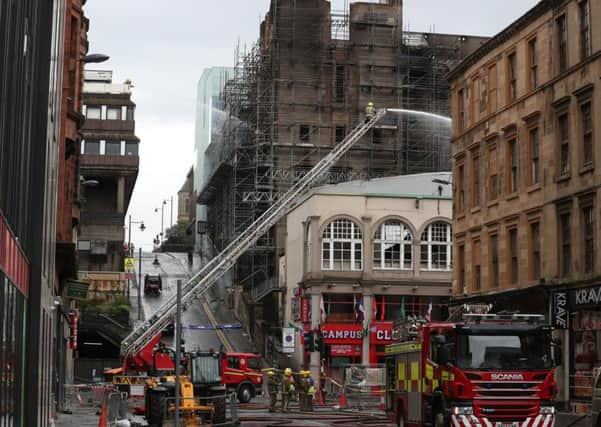Who is the Glasgow School of Art really for? – Laura Waddell


At the weekend the Sunday Post reported insurance covered costs of the initial rebuilding project following the devastating Mackintosh building fire in 2014, and millions of pounds of donations from emotive fundraising drives have actually gone into the purchase of new property and the growth of student numbers.
Starry sponsors aside, many former students and interested members of the public contributed. It feels disingenuous at best to fundraise using sentimental language in appeals to save a great building when cash appears to have been spent in a way not explicitly clear – and particularly when the costs of building a second time are set to be much higher. Politicians calling for a public inquiry are right to do so.
Advertisement
Hide AdAdvertisement
Hide AdThis is only the latest revelation suggesting trust in the Art School governance is dissipating. Recently we learned over 70 staff members have quit in the last year, a high and alarming number, and there are whispers of dissatisfaction with gagging orders preventing criticism. And as if that wasn’t concerning enough, postgraduate students of fine art have demanded reimbursement, unsatisfied with working conditions. Diverting donations borne of love for the Mack into expansion feels as misguided in priorities as inflating a bouncy castle in the garden while the real house is crumbling at its foundations.
Online fundraisers have proliferated since the advent of crowdfunding platforms, and they’ve provided new opportunities to analyse what happens after hands are held out for money. Other than product or campaign launches where there should be a clear outcome, not always do donors know exactly where their money is going, and in some cases they don’t care, content that charities, for example, will do what they wish with the funds. What’s key in those transactions is trust that money will be used wisely and effectively, supporting core principles.
But we’re also in the age of the grifter. It feels like being taken advantage of when emotive pleas for help are followed by unexpected or flashy spending, or when there’s a lack of clarity and accountability. The two-way process required in fundraising can be easily undermined. Goodwill erodes as trust does.
Astonishingly, the GSA board have at times appeared irked by being questioned at all on the two disastrous fires. Muriel Gray, while Chair of the Board of Governers (currently on temporary leave), made defiant media appearances and at the Scottish Parliament culture committee, striking a jarring tone for circumstances of repeated architectural travesties. We have been told over and over again the Mack building is important to students, to Glasgow, and to Scotland in the same breath as insistence on its continued private governance. An air of ‘this is my ball, and just remember you can’t play with it’ doesn’t quite gel with the building’s status of national significance.
Promises to sound out the local community, which we are told is important to the Mack, have been undermined by residents and local businesses associations openly hostile to the idea that they’ve been properly considered or consulted about the site’s evolution. Commentary, no matter how expert, has been put in its place as personal opinion, drawing a dividing line between outsiders and those on the inside of what increasingly looks like battalions.
Recently in Oxfam Books I picked up a copy of Visions of Scotland by GS Fraser, published in 1952. It describes the various cities and places in Scotland from somewhat of a distance, writing for audiences elsewhere, and while full of charms is not always favourable in its assessments. Glasgow’s chapter makes fascinating reading in particular, describing the city as “a country of danger and frustration” and quoting Edwin Muir on “the feeling of walking in a world of intense and brooding sexual passion”. There is distaste for the cheap pleasures of the common people, and a little gothic melodrama with depictions of railway arches and shadows, but taking the perspective with a pinch of salt, it’s still a reminder of a darker period in Glasgow when poverty, sickness and violence came first in public perception. It makes it all the more remarkable that the chapter opens with esteem for the “internationally famous” Glasgow School of Art. “The people of Glasgow are not, in fact, such philistines as the people of Dundee,” says Fraser, complaining that the city’s Town House built by William Adam was demolished in 1931.
What tourists learn now is very different. Recently overheard from a double decker tour bus on Sauchiehall Street, in view of scaffolding up the hill, incredulous words over the guide’s microphone: “…in 2014, and AGAIN in 2018!” If it weren’t actually true, it might so surreal as to be funny, but it’s still a shock to think the building burned down twice in four years.
Who is the art school really for? Sometimes the emotions and opinions of anyone invested in Scotland’s history have only seemed to matter when there is money to be raised. The words “it is not up for discussion” belong absolutely nowhere near a national treasure.
Advertisement
Hide AdAdvertisement
Hide AdThe Mack might be gone but the memories of many fill the space. Those who’ve walked the halls term after term, and those who’ve never set foot in the building but looked at it from afar, wondering what their city means to them. We’ve lost the wear and tear thousands of people left on the staircases and stonework, many no longer with us, but art conceived there has journeyed on through the wider world. Petty kingdoms with distant strains of ‘I’m the Queen of the Castle’ don’t fit that beautiful and visionary old mould and look very small in the face of its history.
A pragmatic, forthright, and democratic spirit suits Glasgow’s temperament. That as well as a sense of what art and architecture means to Scotland’s people must light the next steps for the Art School.